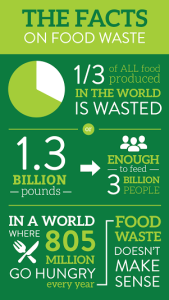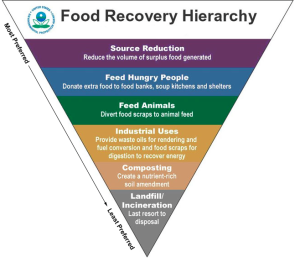
When we’re full, we throw away our extra food. When produce goes bad, we throw it away. Stores throw away quality vegetables and manufacturers dispose of more product than they know what to do with. It’s not hard to see where or why food is wasted.
It is estimated that 37 million tons of food is wasted every year on the planet, equaling to about 1/3 of all food that is produced. In a world where some 805 million people (13.5% in developing countries) do not have enough to eat, those numbers are astounding. The elimination of food waste by regulating food distribution is a problem that we need to fix before it’s too late.
When uneaten food is flippantly discarded, so is the water, energy, labor, land, and fertilizers used to produce that food. When food waste rots in landfills, it produces methane which has 21 times more of an effect on global warming than carbon dioxide. Moreover, nutrients found in food can never be returned to the soil when placed in a landfill.
Food is wasted at all stages of production. On farms, produce with blemishes are immediately discarded. Restaurants also throw away food that doesn’t look nice. Grocery stores dispose of products that have passed their code date even though usually the shelf life of such products far exceed the expiration date. Lastly there is us, the consumers, who buy and prepare too much food, only to throw it away when it goes bad or when we are not hungry enough.
Where food waste occurs also depends on the area of the world. In developed countries, the consumer is responsible for the most wasted food. In developing countries, most food is wasted during or after harvesting simply because they lack the resources necessary to properly store food, which allows the food to spoil or be infested with insects, leaving it unfit to consume.
The good news is that food waste and the need to reduce it has been gaining traction lately. Just this past month on September 16th, the U.S. Department of Agriculture (USDA) and the Environmental Protection Agency (EPA) announced a target for the reduction of food waste: 50% by 2030. Numerous initiatives have also popped up around the world all in effort to address the reduction of food waste. The EPA’s Food Recovery Challenge helps food manufacturers and grocers to adopt sustainable food management practices by reducing the impact of products throughout their lifecycle. This program helps manufacturers reduce food waste by following this hierarchy:
By using this system, the EPA hopes to encourage food manufacturers and grocers to reduce food waste first by only manufacturing an amount of food that is needed to avoid surplus. As surplus is usually unavoidable given out current system, the EPA encourages the donation of their discarded groceries to local food banks. This way, food waste can be diverted from landfills and help to feed the millions of hungry people all over the world.
Similarly, many food manufacturers such as Nestle, Target, Tyson, and General Mills also belong to the Food Waste Alliance. Their goal is to work together to reduce food waste by decreasing the amount of waste generated, donating food to those in need, and recycling unavoidable food waste.
Another great resource for reducing food waste has also popped up on many college campuses. The Food Recovery Network unites students to fight food waste by recovering food that would otherwise be thrown away at their campus restaurants and dining halls and donating it to people in need.
There’s a lot of good happening out in the world to reduce food waste, but it isn’t just up to large food manufacturers to tackle the problem of food waste. After all, in the U.S. most food waste occurs at the consumer level. So what can consumers do to reduce food waste? Consumers can reduce food waste with a system similar the Food Recovery Hierarchy, just like food manufacturers. Consumers can first decrease the amount of food that they buy or make. If they buy too much on accident, consumers can always save leftovers to be eaten at another time or share with friends and family. Surplus can also be stored in multiple ways such as freezing and canning, which prolongs the life of the food. For surplus food that is not fit to be eaten, composting can be a great choice. Composting allows food waste to be converted into fertilizer for gardening.
While food waste and its implications are a big problem, its solutions are easily identifiable. The first step is public education. As a recent article by Minnesota Public Radio states: “ there was a time when people rolled down their windows and tossed trash onto highways…but now, this is not culturally acceptable. That’s because there was a massive public education campaign…the goal is to create a generation of Americans that are sensitive to food waste”.
Sources:
Infographic by Julia Farrell
http://www2.epa.gov/sustainable-management-food/food-recovery-challenge-frc
http://www.foodrecoverynetwork.org/#about
http://www.foodwastealliance.org
http://www.npr.org/sections/thesalt/2015/09/16/440825159/its-time-to-get-serious-about-reducing-food-waste-feds-say
http://www.npr.org/sections/thesalt/2015/09/16/440825159/its-time-to-get-serious-about-reducing-food-waste-feds-say
http://www.npr.org/sections/thesalt/2015/09/16/440825159/its-time-to-get-serious-about-reducing-food-waste-feds-say
Originally from South Dakota, Katie graduated with a degree in food science from the University of Minnesota in May and is now starting her career as a contract technologist at a major food company. She is interested in anything that has to do with food: where it comes from, how it’s made, and how its production affects the planet. She believes in a hybrid between the conventional food industry and more organic industry of recent years, and feels strongly on the need to bridge the gap between science and the public through writing. As an avid cook and reader, Katie enjoys a wide variety of literature and trying out new recipes. Some of her favorite things in life include hiking, Starbucks, and cats.
Did you enjoy Katie’s article on food waste? Read more by her here!











Thank you for this post! It’s good to read some more about this important problem, and I think it’s very important for everyone of us to know that reducing the food waste is each person’s individual mission. If we don’t do attempts on this every day, in our homes, work, etc. the facts we read will continue to be disturbing, the percents will grow…Definitely recommending your post to my friends. Greets!